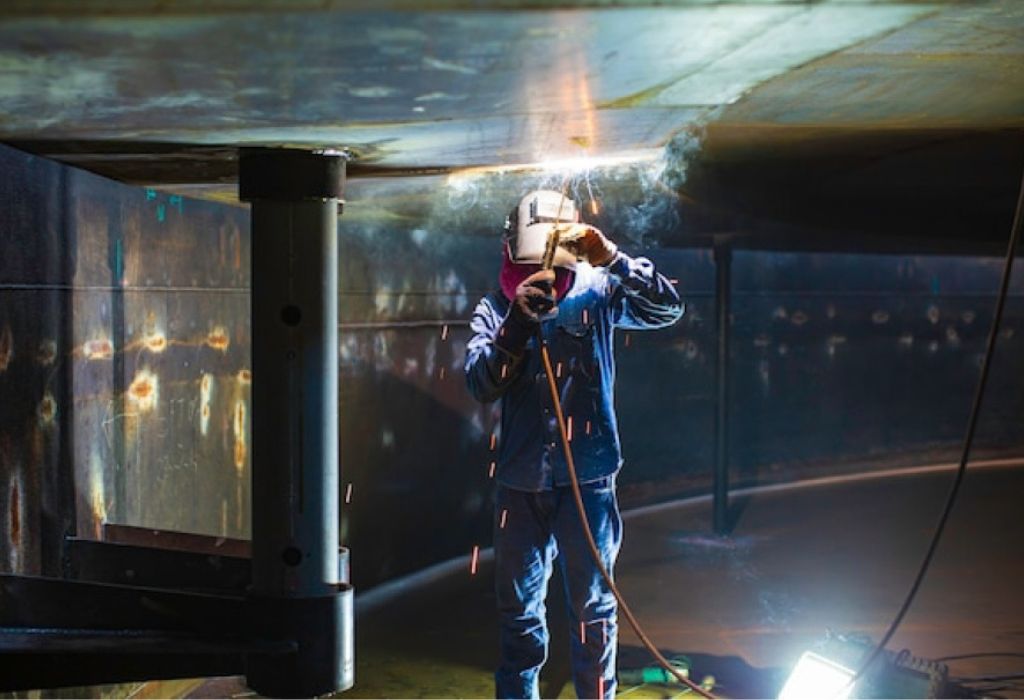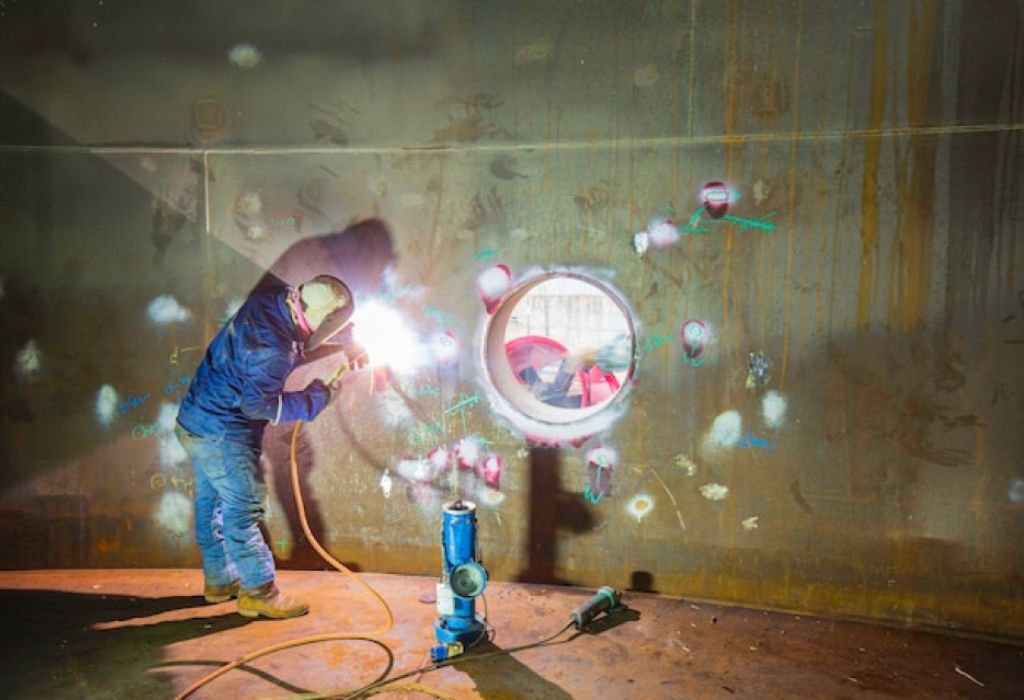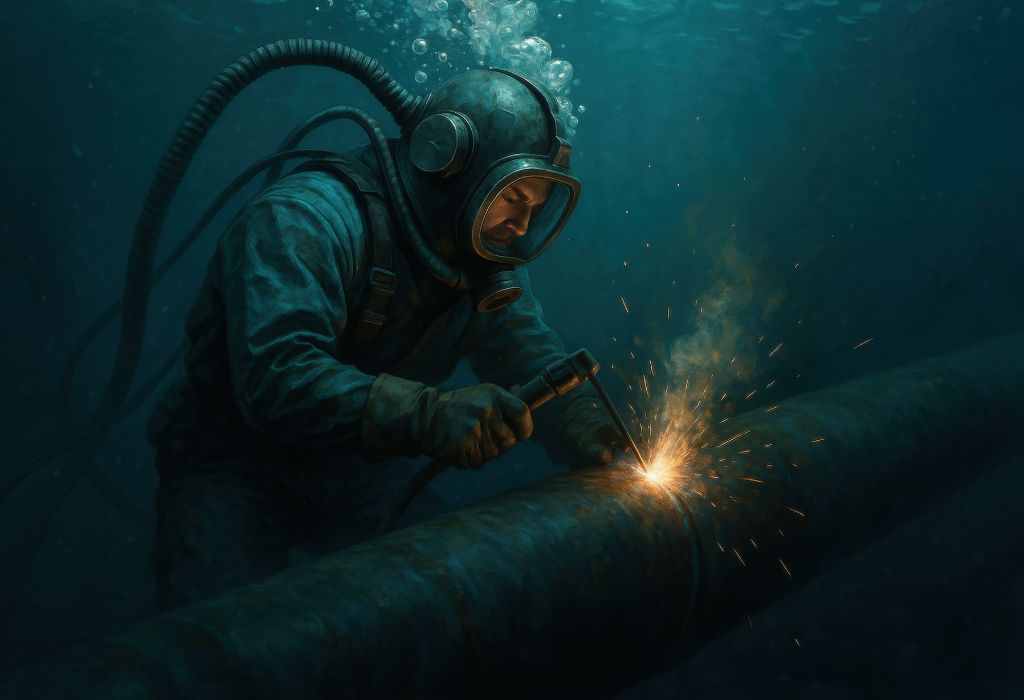A storm rocks the surface while a diver in heavy gear descends into cold, murky water. His mission is critical: inspect, cut, and repair structures that keep industries moving.
This leads many to ask a simple question—what does a underwater welder do in a typical day.
Underwater welders are more than just tradespeople; they are commercial divers who combine welding skills with the ability to work safely under pressure.
Their work ranges from repairing ship hulls and offshore platforms to maintaining pipelines, bridges, and dams.
These tasks cannot wait for calm seas, making underwater welders vital to global infrastructure.
The profession is diverse. Some welders perform “wet welding” directly in the water, using waterproof electrodes, while others work inside dry hyperbaric habitats where conditions mimic topside welding.
The choice depends on project demands, budget, and required weld quality.
According to the American Welding Society, underwater welding is used worldwide in industries worth billions of dollars, from oil and gas to shipping and civil construction.
At the same time, safety concerns remain high, as divers must follow strict protocols to avoid electric shock, decompression sickness, and equipment failure source.
Each dive day follows a routine: equipment checks, briefings, descent, task execution, ascent, and decompression.
Beyond welding, tasks may include inspection, cutting, rigging, or installing protective clamps. With every job, accuracy and safety are non-negotiable, since mistakes at depth can be costly—or deadly.
By exploring tools, techniques, risks, and training, this guide reveals the reality of underwater welding.
If you’ve ever wondered what does a underwater welder do, the answer lies in a blend of diving expertise, technical skill, and the resilience to work in one of the world’s most extreme environments.
Underwater Welding 101: Where, Why, and How

Underwater welding, also called hyperbaric welding, is the process of joining metals while submerged. It is performed by trained commercial divers who double as welders.
Worksites vary widely. Offshore oil platforms, subsea pipelines, ship hulls, dams, and bridge piers all rely on underwater welders for critical repairs.
There are two main types of underwater welding. Wet welding happens directly in the water, while dry welding takes place in a pressurized habitat that creates a dry environment.
Wet welding is faster and cheaper, but weld quality can be lower. Dry welding provides higher control and durability, often required for code-compliant joints.
What does a underwater welder do most days?
They cut, weld, inspect, and maintain underwater structures to keep industries running.
Where is underwater welding used most?
In oil and gas, shipping, and civil engineering projects like bridges and dams.
What is the difference between wet and dry welding?
Wet uses waterproof electrodes in open water, while dry uses a sealed chamber with controlled gases.
Who controls the welding power?
Surface crews activate and deactivate power for safety on the diver’s command.
Why is underwater welding essential?
Because structures submerged in water cannot be removed easily, welders perform repairs in place.
Daily Workflow: From Toolbox Talk to Decompression
A typical day for an underwater welder begins before entering the water. The team conducts a toolbox talk to review the project scope and safety protocols.
Next comes equipment checks. Every helmet, umbilical, stinger, and power source must be inspected for reliability.
The diver then suits up and descends into the work area. Constant communication with the surface crew ensures coordination and safety.
Once the job is complete, the diver ascends and begins decompression if required. Finally, the day ends with a debrief to log results and discuss improvements.
How does a dive day start?
With planning, safety checks, and review of underwater procedures.
What tools are common besides welders?
Cutting torches, hydraulic grinders, inspection gauges, and cameras.
Why is communication important?
Surface teams control power and monitor diver safety throughout the task.
What happens after welding is done?
Divers must decompress safely to prevent dive-related injuries.
Why is debriefing critical?
It ensures records are accurate and future jobs benefit from lessons learned.
Core Tasks: Inspection, Cutting, Fitting, Welding, and NDT
Inspection is often the first step of a job. Divers check for cracks, corrosion, and alignment issues.
Cutting follows when damaged material needs removal. Exothermic cutting rods and burning bars are common tools.
Welding is next, using waterproof electrodes for wet work or advanced processes in habitats. The goal is to restore or strengthen critical structures.
Finally, non-destructive testing (NDT) verifies the weld’s quality. Surface crews may use ultrasonic or magnetic testing methods.
Why is inspection so important?
It defines the scope of work and ensures accurate repairs.
How do underwater welders cut metal?
With specialized rods that burn even in water.
Which welding processes are common?
Wet SMAW and dry GTAW or FCAW depending on environment.
How are welds verified?
Through NDT methods that detect defects without damaging the weld.
Do welders also install components?
Yes, they may fit clamps, brackets, or anodes as part of repairs.
Wet vs Dry Welding: When Each Method Wins
Wet welding is the faster and less expensive method. It is often used for emergency or temporary repairs.
Dry welding inside a hyperbaric habitat provides better conditions. It is chosen when quality and precision are critical.
The decision depends on time, budget, and client requirements. Both methods remain essential tools for underwater welders.
Why use wet welding?
It is quick and suitable for short-term fixes.
When is dry welding required?
For long-term structural integrity and code-compliant joints.
Is wet welding less durable?
Yes, it is more prone to porosity and cracking.
Does depth affect method choice?
Yes, greater depths often require habitats for safety and quality.
Which industries use dry welding most?
Oil, gas, and shipping where safety standards demand reliability.
Typical Projects by Industry

Underwater welders support oil and gas by repairing risers and pipelines. Offshore platforms rely on them for constant maintenance.
Civil projects also depend on their skills. Dams, bridges, and docks often require submerged welding to extend service life.
Shipping uses welders to repair hulls and propellers without drydocking. Salvage companies also hire welders for recovery operations.
Do they only weld offshore?
No, many jobs happen in inland waterways and ports.
What are the main offshore tasks?
Pipeline repair, structural reinforcement, and platform maintenance.
What about civil construction?
Bridge piers, dams, and intakes often need underwater repairs.
Are ship repairs common?
Yes, welders often fix cracks and damage without removing the ship from water.
Can underwater welders work in freshwater?
Yes, rivers and lakes also require submerged welding.
Tools and Gear of an Underwater Welder
The diver’s helmet is the most critical piece of gear. It provides breathing gas, communication, and protection.
The umbilical supplies air, power, and signals. It connects the diver to the surface team.
The welding stinger is insulated to handle underwater conditions. Power is only activated when the diver is ready.
Protective suits, knives, and harnesses complete the setup. Each tool is vital for both safety and productivity.
What protects divers most?
A sealed helmet with reliable gas flow and comms.
How is welding power supplied?
Through a DC source controlled at the surface.
Why use waterproof electrodes?
Their flux coating creates gas bubbles to shield the arc.
What clothing do welders wear?
Hot water suits or dry suits depending on temperature.
Do they carry emergency tools?
Yes, knives and cutting devices are always on hand.
Safety and Risk Management
Underwater welding combines diving hazards with electrical risks. This makes it one of the most dangerous skilled trades.
Decompression sickness, electric shock, and drowning are constant threats. Strict procedures and backup divers mitigate these risks.
Surface crews monitor power and gas to ensure control. Emergency drills prepare teams for unexpected problems.
Is it a dangerous job?
Yes, it carries higher risks than many trades.
How is electric shock prevented?
By using insulated tools and surface-controlled switches.
Why is decompression important?
It prevents nitrogen bubbles from forming in the blood.
What backup exists?
A standby diver is always ready for rescue.
Are accidents common?
Not with proper training and adherence to safety protocols.
Training and Certification
Becoming an underwater welder requires dual skills. First, candidates train as commercial divers.
Next, they master welding processes like SMAW and GTAW. Certification programs combine both disciplines.
Specialized schools teach hyperbaric welding. Many graduates move into offshore or inland projects.
Do you need a welding background first?
Yes, topside welding experience is usually required.
Which certifications matter?
Commercial diving and welding codes approved for subsea work.
Is training expensive?
Yes, programs can cost tens of thousands of dollars.
Can welders work inland only?
Yes, some choose rivers and lakes instead of offshore rigs.
Is saturation diving part of training?
Not at entry level, but advanced divers may pursue it.
A Day in the Life: Example Scenarios
On a bridge pier job, welders cut away corroded steel and attach new plates. Inspections confirm stability before reopening the bridge.
On an oil rig, a diver enters a habitat to weld a critical joint. The weld is tested and logged before the habitat is depressurized.
On a ship hull, wet welding is used to patch a crack. This avoids costly drydocking and keeps the vessel in service.
How long is a shift?
It varies, but dives are carefully timed to limit exposure.
Do welders always weld?
No, many days are spent inspecting, cutting, or fitting.
Who approves weld quality?
Inspectors and engineers verify results with NDT.
Is every job dangerous?
Yes, but risks are managed with strict procedures.
Do welders travel often?
Yes, many projects require global mobility.
Career Outlook and Pay Drivers

The career offers high pay but comes with high risk. Offshore work often pays more due to danger and travel.
Inland welders earn less but face steadier schedules. Pay depends on depth, experience, and certifications.
Demand remains strong worldwide. Infrastructure and energy projects continuously require underwater welding.
Is it a high-paying job?
Yes, especially offshore with hazard pay.
What affects salary most?
Depth, danger, and technical skill.
Are jobs stable?
Yes, but project-based work means contracts vary.
Do welders retire early?
Some do, due to physical strain.
Is demand growing?
Yes, global infrastructure ensures ongoing work.
Conclusion
So, what does a underwater welder do every day? They dive into extreme environments to cut, weld, inspect, and maintain critical structures that keep the world moving.
From offshore rigs to inland bridges, underwater welders balance technical skill with diving expertise. Their work is risky, but it is essential to global industry.
For those ready to pursue the path, training in both welding and diving opens the door to one of the most demanding and rewarding careers in the skilled trades.

I’m Darrell Julian, the founder, lead writer, and hands-on welding enthusiast behind ArcWeldingPro.com. With more than 15 years of real-world welding experience, I created this platform to share what I’ve learned in the field, in the shop, and in the heat of the arc.


